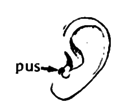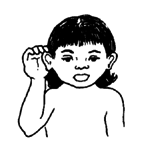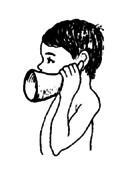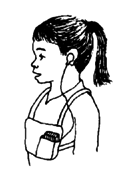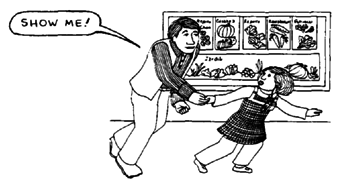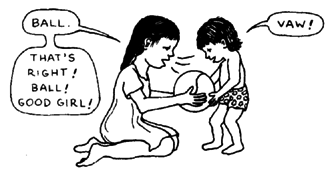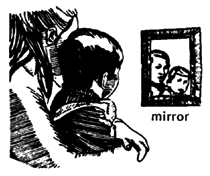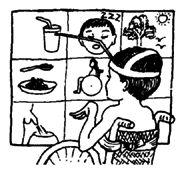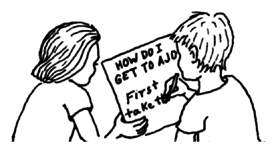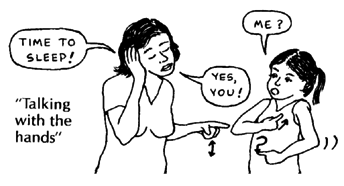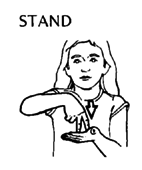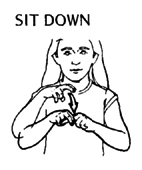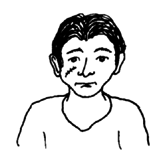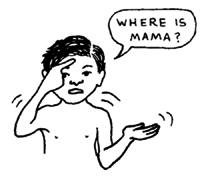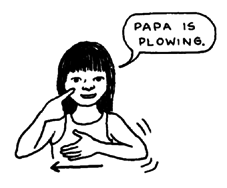Disabled Village Children
A guide for community health workers,
rehabilitation workers, and families
PART 1
WORKING WITH THE CHILD AND FAMILY:
Information on different Disabilities
B. Recognizing, Helping with, and Preventing Common Disabilities
CHAPTER 31
Deafness and Communication
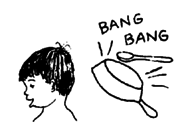
The child who is completely deaf does not respond even to very loud noises. (But he may notice movements or vibrations caused by sudden loud noises. For example, clapping behind the child's head may move the air at his neck and cause the child to turn.)
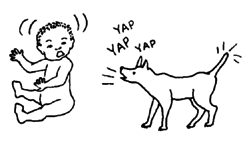
The child who is only partly deaf hears some sounds, but may not hear clearly enough to tell the difference between certain sounds or words. Families are often slow to recognize that these children have difficulty hearing.
Different children have different amounts of hearing loss
A few children are completely deaf; they do not hear at all. Parents often notice early that their child cannot hear, because she does not turn her head or respond, even to loud sounds.
Much more often, children are partly deaf. A child may show surprise or turn her head to a loud noise, but not to softer noises. She may respond to a low-pitched sound like thunder, a drum, or a cow's 'moo', but not to high-pitched sounds like a whistle or a rooster crowing. Or (less commonly) a child may respond to high-pitched sounds but not low ones.
Some children who are partly deaf hear a little when people speak to them. They may slowly learn to recognize and respond to some words. But many words they do not hear clearly enough to understand. They are slow to begin to speak. Often they do not speak clearly, mix up certain sounds, or seem to 'talk through their nose'. Unfortunately, sometimes parents, other children, and teachers do not realize that the child has difficulty hearing. They may treat her as if she is mentally slow, or 'dumb'. This only increases the child's problems.
Problems that may result
|
COMMUNICATION is the way in which we understand what is said to us and the way we say or express to other people our thoughts, needs, and feelings. People who can hear communicate mostly through speech. |
For most growing children, hearing and language are very important for getting to know, understand, and relate to the people and things around them.
For a child with a hearing loss, the biggest problem is learning to communicate. Because she cannot hear words clearly, it is much more difficult for her to learn to speak. So she has trouble both understanding what people want, and telling them what she wants. This can lead to frequent disappointments and misunderstandings, both for the child and others. It is no surprise, then, that children with hearing loss sometimes are slow in learning to relate to other people, feel lonely or forgotten, or develop 'behavior problems'.
The exchange of ideas and information through some form of communication is important for the development of any child's mind. Most deaf children are just as intelligent as other children. But for their mental ability to develop fully, they need to learn to communicate well from an early age.
How deafness affects a child depends on:
-
when the child became deaf. For a child who is born deaf or becomes deaf before he begins to speak, learning to speak or 'read lips' will be far more difficult than for a child who loses his hearing after he has begun to speak.
-
how much the child still hears. The better the child hears, the more chance he has of learning to speak, understand speech, and 'read lips'.
-
other disabilities. Some deaf children also have other problems. A child who is mentally retarded, blind, or 'multiply disabled' will have a harder time learning to communicate than a child who is deaf only. (See "Causes of Deafness.")
-
how soon the problem is recognized.
-
how well the child is accepted, and how early he is helped to learn other ways to communicate.
-
the system of communication that is taught to the child ('oral' or 'total', see Page 263).
|
CAUSES OF DEAFNESS Deafness is not caused because the child did something wrong or because someone is being punished. Common causes before a baby is born:
Common causes after birth:
Other causes. There are many other less common causes of deafness. In 1 out of 3 children the cause is not known. |
Importance of early recognition of deafness
During the first years of life, a child's mind is like a sponge; it learns language very quickly. It a child's hearing problem is not recognized early and effective help is not provided, the best years for learning communication skills may be lost (age 0 to 7). The earlier special training begins, the more a child can learn to communicate.
Parents should watch carefully for signs that show if a baby hears or not. Does the baby show surprise or blink when you make a sudden loud noise? As the baby grows, does he turn his head or smile when he hears familiar voices? Has he begun to say a few words by 18 months of age? Does he say a lot of words fairly clearly by age 3 or 4? If not, he may have a hearing problem. As soon as you suspect a problem, test the child's hearing.
Simple tests for hearing are on Page 450 and 451. If it seems the child does not hear well, when possible, take him to a specialist for testing.
Unless a child is given a lot of understanding and help learning to communicate from an early age, deafness can be one of the most difficult, lonely, and misunderstood disabilities. The following 2 stories will help show the difference that it can make to recognize a hearing problem early and provide the extra help that the child needs.
TONIO
Although Tonio was born with a severe hearing loss, his parents did not realize this until he was 4 years old. For a long time, they thought he was just slow, Or stubborn.
Until he was one year old, Tonio seemed to be doing fairly well. He began to walk and play with things. Then his sister, Lota, was born. Lota smiled and laughed more than Tonio when their mother talked or sang to her. So their mother talked and sang to Lota more.
By the time Lota was 1, she was already beginning to say a few words. Tonio had not yet begun to speak. 'Are you sure he can hear?" a neighbor asked one day. "Oh yes,'' said his mother. She called his name loudly, and Tonio turned his head.
When he was 3, Tonio could only say 2 or 3 words. Lota, at age 2, now spoke more than 200 words. She asked for things, sang simple songs, and played happily with other children. Tonio was more moody. Mostly he played by himself. When he played with other children it often ended in fighting-or crying.
Lota behaved better than Tonio. Usually, when her mother told her not to do something and why, she understood and obeyed. Often, to make Tonio obey, his mother would slap him.
One time in the village market Lota asked for a banana and her mother bought her one. A moment later, Tonio quietly picked up a mango and began to eat it. His mother slapped him. Tonio threw himself on the ground and began to kick and scream.
When Tonio's father heard what had happened in the market, he looked angrily at Tonio and said, ''When will you learn to ask for things? You're 4 years old and still don't even try to talk. Are you stupid, or just lazy?''
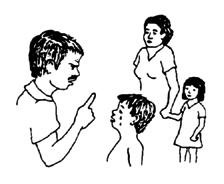
Tonio just looked at his father. Tears rolled down his cheeks. He could not understand what his father said. But he understood the angry look. His father softened and took him in his arms.
Tonio's behavior got worse and worse. At age 4 his mother took him to a health worker, who tested Tonio and found that he was deaf.
Now Tonio's parents are trying to make up for lost time. They try to speak to him clearly and slowly, in good light, and to use some signs and gestures with their hands to help him understand. Tonio seems a little happier and speaks a few more words. But he still has a lot of trouble saying what he wants.
SANDRA
When Sandra was 10 months old, her 7-year-old brother, Lino, learned about testing for deafness as part of the CHILID-to-child program at school (see Page 450). So he tested his baby sister. When he stood behind her and called her name or rang a bell, she did not turn or even blink. Only when he hit a pan hard did she show surprise. He told his parents he thought Sandra did not hear well. They took Sandra to a small rehabilitation center. A worker there tested Sandra and agreed she had a severe hearing loss.
The villageer explained what the family could do to help Sandra develop and learn to communicate. He gave them many drawings of hands held to make 'signs' for common words.
"Every time you speak, make 'signs' with your hands to show what you mean. Include all the signs and gestures that people already use in your village. Teach all the children to use them too. Make a game out of it. At first Sandra won't understand. But she'll watch and learn. In time she'll begin to use signs herself."
"If she gets used to signs, won't that keep her from learning to speak?'' asked her father.
"No," said the worker. "Not if you always speak the words at the same time. The signs will help her understand the words, and she may even learn to speak earlier. But it takes years to learn to speak with 'lip reading'. First, she needs to learn to use signs to say what she wants and to develop her mind."
Sandra's family began using signs as they spoke to each other. Months passed, and still Sandra did not begin to speak or to make signs. But now she was watching more closely.
By age 3, Sandra began to make signs. By age 4 she could say and understand many things with signs-even lip read a few words, like 'Yes', 'No', and 'Lino'. By age 5 she had only learned to 'lip read' a few words. But with signs she could say over 1000 words and many simple sentences.
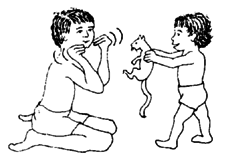
Sandra was happy and active. She liked to color pictures and play guessing games. Lino began to teach her how to draw letters. One day she asked Lino when she could go to school.
WHERE CAN YOU GO FOR HELP?
A child who does not hear well needs extra help. Where you can look for help depends on where you live and on what resources are in your community and in your country. Here are some possibilities:
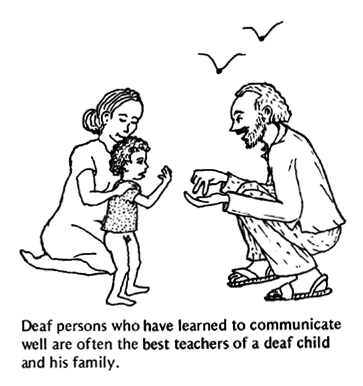
-
Local deaf persons as teachers. Even a small village usually has some persons who have been deaf a long time. Probably they will have learned to communicate through signs and gestures. If you ask some of them to become the friends and teachers of a deaf child, and advisers to the family, often they will be glad to do so. They may remember the difficulties and loneliness of their own childhood and want to help provide the understanding and learning opportunities that the deaf child needs.
Deaf persons can be especially helpful if they have learned the 'national sign language' and can communicate fully with other deaf persons. If there is no such person in your village, but there is in a neighboring town, perhaps the child can visit that person, or a group of deaf persons.
-
Other families with deaf children. If several families with a deaf child can come together, share experiences, and learn as a group, this can be a big help. The younger deaf children can learn from older ones, or from deaf adults. Together they can develop a form of communication so that all the children and their families can understand each other.
-
The National Association of the Deaf (or other group run by the deaf.) Most countries have associations of deaf persons. These can give you information about the national sign language in your country, and perhaps send books for learning it. They can tell you about training programs for the deaf (government, private, and religious) and can advise which are the best. They may even provide brief training in basic communication skills to a local health worker, teacher, family member, or disabled child-with the understanding that he or she then teach others.
-
'Special education' programs or schools for the deaf. Many countries have schools where deaf children can live and receive special training. Some of these are good and some are not. Good programs try different methods of communication with each child and then focus on what will probably work best for that child in his community. Bad programs try to make all deaf children communicate only by lip reading or speech. For many children this can lead to failure, anger, and emotional harm (see Page 264). Try to get advice from educated deaf persons.
At first it may be difficult for parents to let their child go away to school. But learning to communicate well can be important to the child's life. Be sure to check the costs and plan ahead. Some schools may be free or have low fees.
Deciding what to do for a deaf child
Not all children with hearing loss are the same. All need love, understanding, and help learning to communicate. But different children need different kinds of help, to communicate in whatever way works best for them. We must adapt our methods to the needs of the particular child and to the realities of the community where he lives.
-
If a child is only partly deaf, sometimes we can help her to hear more clearly (see Page 262), to understand more speech, and perhaps learn to speak.
-
A child who has no hearing at all usually cannot be helped to hear. But if he became deaf after he began to speak, perhaps he can be helped to 'read' people's lips and to improve his speech.
-
If the child was born deaf and has never heard speech, learning to lip read and speak is always very slow and difficult, and is usually not very successful. It is better to help the child learn to communicate in whatever ways work best for her: first with her face, body, arms and hands, then possibly adding pictures, reading and writing, finger spelling, and as much lip reading and speech as she is able to learn.
-
If the child comes from an area where there are many deaf people who communicate with each other in a national sign language, it is probably best to have people in the deaf community help teach the child and her family their language. That way, she can learn to communicate with deaf people as fully and well as hearing people communicate with each other.
-
But if the child lives in a small village where there are few deaf people, none of whom know the national sign language, learning that language may not help the child much. Probably it makes more sense for her to learn ways to communicate as best she can with those who can hear. Again, this probably means a combination of methods, based on the signs and gestures people already use in the village. With these, the child can also use pictures, and later perhaps, reading and writing.
-
Remember, most children with hearing loss can learn quickly. But some may have brain damage or disabilities that affect their ability to learn or to control their hands, lips, or voices. You will need to figure out ways to help these children communicate in whatever way they can: with sets of pictures, head movements, or eye movements.
![]()
|
Note: Some children who hear perfectly well do not develop the ability to speak. Some children with cerebral palsy do not control their mouth or tongue movement well enough to speak. Other children are mentally retarded and may be very late in learning to speak, or never learn. Other children are intelligent in many ways, but for some reason cannot speak. For all of these children, we need to look for ways to help them communicate as best they can. |
Helping a child to hear better
Children who are not completely deaf can sometimes be helped to hear better:
- When possible, have the child's hearing and ears examined by a specialist. A few children are born with a closed ear tube or other defect in the structure of the ear. Rarely these problems can be corrected by surgery, and the children can hear better. (Note: For children whose hearing loss comes from brain damage, surgery will not help.)
- Children who have hearing loss because of ear infections may begin to hear better if the ear infections are treated early and steps are taken to prevent more infections. (See Page 276.)
- Some children can hear better with aids that make sounds louder. A 'hearing aid' allows some children to understand words fairly well, and can make a big difference in learning to listen and speak. For other children, an aid makes them more aware of sounds (which helps) but does not help them to tell the difference between words. If it appears the child will benefit a lot from a hearing aid, it helps to begin as early as age 1 or 2.
|
The simplest aid is a hand cupped behind the ear.
|
|
Better is an 'ear trumpet'. You can make one out of a cow horn, cardboard, or tin.
|
|
Better still (for some children) is a 'hearing aid' with batteries. But usually these are very expensive. For best results, it should be fitted by a specially-trained worker after the child's hearing has been carefully tested.
|
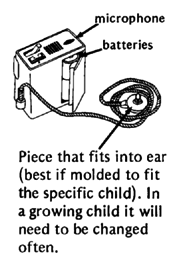
|
CAUTION: If you get a child a hearing aid, be sure to ask for instructions on keeping it clean, dry, and working well. Be sure you have a supply of extra batteries and know how to get more. |
-
Young children who do not hear well can sometimes be helped to listen more carefully, and to learn the difference between sounds:
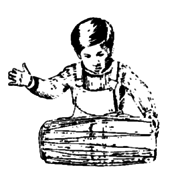
Make different sounds and encourage the child to take notice. When a donkey brays or a baby cries, say clearly and loudly, "Listen to the donkey," or "What was it?" If the child answers or points in the right direction, praise him.
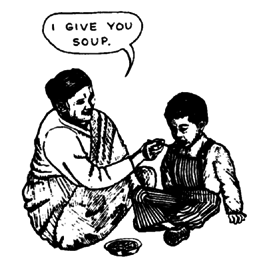
Have the child make different sounds - hitting pans, drumming, ringing bells, and so on. See if he can move or dance to the beat of music or drums.
Talk a lot to the child. And sing to her. Tell her the name of different parts of her body, and other things. Ask her to touch or point to them. Praise her when she does.
Experiment to find out how near the child's ear you need to be, and how loud you have to speak, to get the child's attention, or for him to repeat the sounds you make. Then try to speak near and loud enough. Speak clearly, but do not shout.
DIFFERENT WAYS TO HELP A CHILD COMMUNICATE
|
COMMUNICATION BY SHOWING
|
|
HELP WITH HEARING AND SPEAKING
|
|
LIP READING
|
|
COMMUNICATION BY PICTURES AND POINTING
|
|
FINGER SPELLING
For finger spelling alphabet in English see Page 273. |
|
READING AND WRITING
|
|
SIGN LANGUAGE
|
Oral communication
Oral communication (communication by mouth) combines helping a child use herlimited hearing as much as possible, with lip reading, and with learning to speak. In many countries, schools for deaf children teach only oral communication. Unfortunately, oral communication usually only works well for children who can hear the differences between many words, or for children who became deaf after they learned to speak.
Total communication
Total communication is an approach that encourages a child to learn and use all the different methods that work well for that child in her particular community. This might include any (or all) of these:
- the child's own gestures
- sign language
- drawing, reading, and writing
- finger spelling
- whatever hearing the child has, to develop lip reading and speech
IMPORTANT: 'Total communication' as we use the term, does not mean that all the above methods are used for every child. It means that we try all the methods that might work for a child. Then we work with whatever methods will help the child communicate as easily, quickly, and fully as possible with her family and community. It is an approach that is friendly, flexible, and adaptable to individual and local needs.
WARNING: Beware of programs that teach only oral communication
In many countries, schools for the deaf still try to make all children learn only 'oral communication' (lip reading and spoken words). The results are often disappointing, or even harmful, especially for the child who was born deaf. Lip reading at best gives a lot of problems. A skilled lip reader can only understand about 40 to 50 percent of English words, and has to guess at the rest. (For example "Mama" and "Papa" look exactly the same on the lips.) Even if the child does learn to lip read and speak some, often his words are unclear or sound strange. As a result, when he grows older, often he prefers not to speak.
The biggest problem with teaching only oral communication is that it slows down a child's language development at the age when children learn language fastest (age 1 to 7 years). A deaf child usually learns to lip read and speak only 5 or 10 words by age 5 or 6. By that age, the same child can easily learn over 2,000 signs-as many words as a hearing child speaks.
Studies have shown that deaf children who learn to use gestures and signs can communicate easier, earlier, and more fully than those who are taught only oral communication. Learning sign language and other forms of communication first actually makes it easier for a child to learn to speak and read lips.
For all these reasons, more and more experts and organizations of deaf people recommend teaching most deaf children a combination of communication methods, including some form of sign language.
'Total communication' is not new. In villages in many parts of the world, deaf and hearing persons find imaginative and effective ways to talk with each other. They figure out a system of hand signs, objects, face movements, pictures, and certain sounds or words. As a result, deaf persons often manage fairly well in the community. They can "say" and understand a lot. (See Page 276.)
We know families from villages like these who took their deaf child to 'speech therapists' in the city. Often the parents and child had already begun to communicate with each other by using the local signs and inventing more of their own. The child was happy and learning fairly well. But the therapists told the parents that they were wrong. They told them that they must not let the child use signs, because if he got used to signs he would never learn to speak. They said the child should be put in a 'special education program' and taught 'oral communication'. But since the only programs of this kind are in the cities (and often have a 3-year waiting list) the parents took their child back to the village. Trying to follow the therapist's orders, they tried not to use signs with their child, and punished him when he used them. As a result, both the parents and child felt frustrated, guilty, angry, and hurt. The child's learning and social development were held back. His chances of learning to speak became less than they were when everyone happily used the village system.
Fortunately, most of these families in time realized that they simply could not manage without using signs, and gradually went back to accepting 'total communication'.
In the richer countries more and more special educators and speech therapists are beginning to favor total communication. They have changed to this approach partly because deaf persons have organized and demanded it. Disabled persons in poor countries, including deaf persons and their families, also need to organize. They need to help professionals listen to them, and to respond to their needs in more realistic ways.
Helping a child learn 'total communication'
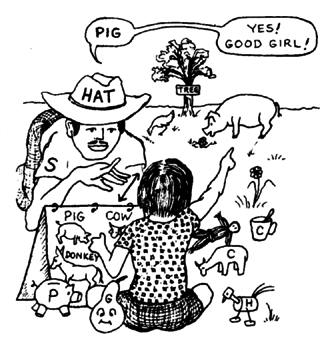
- The learning place should be well lighted, so that the child can see your hands, face, and lips.
- Face the child when you speak to her, and be sure she is watching you.
- Talk to her a lot, even if she does not understand. Talk with your hands, face, and lips, and encourage her to watch them all.
- Speak clear and loud, but do not shout and do not exaggerate the movement of your mouth and lips. This will help her learn to recognize normal speech.
- Be patient and repeat things often.
- Be sure to let her know that you are pleased when she says something or does something well.
- Encourage her to make whatever sounds she can. This will help her strengthen her voice for possible speech.
- Have a lot of toys, pictures, and other things ready to use in helping her learn the signs and words for them.
- Make learning to communicate fun. Include other children in games like 'Simon says' that help children use their eyes, ears, and bodies, and copy each other (see Page 316).
- Play games that exercise the child's lips, tongue, and mouth muscles. In a deaf child, these muscles can get weak. This not only makes speech more difficult, but can make the child's face look dull, or without expression. For activities to strengthen and control the mouth and lips, see Page 314 and 315.
- Make a list of the words that other children her age use, and that you most want the child to learn. Include:
· useful words for learning and games: yes, no, thank you, please, what, do, don't, like, want
· common and interesting things: body parts, animals, clothing, foods
· action words: come, go, eat, drink, sleep, give, put, see, hear, wash, walk, run, play, pee
· people: you, I, he, she, it, we, they, Mama, Papa, Juan, María, and other family members
· description words: small, big, up, down, fat, thin, good, bad, hot, cold, day, night
Start with a short list and gradually make it longer. Use the words often, in daily activities (feeding, bathing, dressing), and in play. Have the whole family learn the words on the list and how to make the signs for them. Encourage everyone to use the words and signs together, not only when they talk with the child, but when they talk with each other, and for all the things they do in the home. This way the child will learn about language by playing, watching, listening (as much as he can), and finally by copying-the way most children learn language.
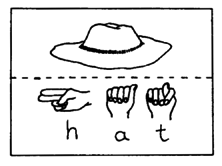
- As the child gets a little older, help her become familiar with letters and written words. You can write the first letter or name of things on different objects around the home. Or make pictures of things with their names in big, clear letters. Or make pairs of 'flash cards' so the child can match pictures with words. This will help the child understand hand signs that are based on letters. It will prepare him for learning the alphabet in writing and signs, and for learning to read and write.
SIGN LANGUAGE
In most villages and communities people use and understand many gestures or signs made with their hands. Most of these signs are 'common sense', or look something like the things they represent. Some children's games use hand signs. For example.




When a family has a deaf child, they begin to use the local signs and also to invent new ones of their own. For example, at a village rehabilitation center in Mexico, a family arrived on muleback with their 6 year old deaf son. The boy got nervous and wanted to go home. So he pulled on his father's shirt sleeve and made these sounds and signs:
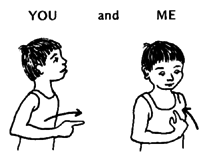
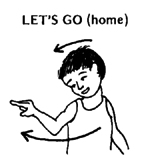
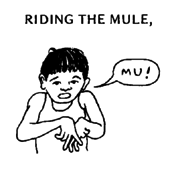
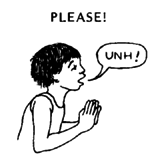
The family had begun to figure out its own sign language, without having been taught it. The boy himself had made up the sign for 'RIDING the MULE'.
The sign language that families develop with their deaf children is usually not very complete. Communicating is often still difficult. However, people have joined together to create sign languages which are much more complete. There are hundreds of different sign languages, but there are 3 main types:
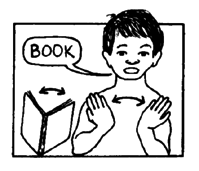
- National and regional sign languages. In nearly all countries, deaf people have created their own sign languages, in which they can learn to communicate as well and nearly as fast as hearing people. Different hand signs represent different things, actions, and ideas. The structure (grammar) of these languages is different from the spoken language, and therefore is difficult for hearing people to learn. These languages are preferred by people who were born deaf. Examples are American Sign Language (ASL), which is used in the USA and Canada, and Mexican Sign Language.
-
Sign languages based on spoken languages. These languages have the same organization and grammar as the local spoken language. They are easier for hearing persons to learn and for persons who became deaf after they learned to speak. Sometimes they use the first letter (finger spelling) of a word as part of the sign. This is harder for children to learn who cannot read, but can make learning to read easier and more fun. Examples are English Sign Language and Spanish Sign Language.
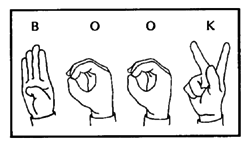
-
Finger spelling. Each word is spelled out with hand signs that represent the letters of the local alphabet. This method of 'writing in the air' is slow but exact. It is easier for persons to learn who can already read and write. For English, the British use a 2-handed system and the Americans use a one-handed system. Try to learn the system that is most used in your country.
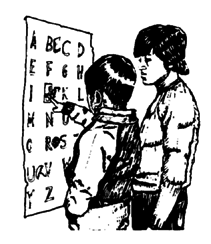
Many deaf persons combine these 3 systems, With other deaf persons they use mostly the first, with hearing persons or a 'translator' they use mostly the second, and finger spell difficult words. When 'talking' to someone who does not know sign language, they can write down what they need to say-or use a letterboard.
Learning to sign
If possible, contact the Association of the Deaf in your country, and see if you can get a guidebook to sign language adapted to your local area or spoken language. If this is not possible, you can use the local signs and gestures, and invent more signs of your own.
On the next few pages we give ideas for making up signs, and examples for common words. Most are signs used in American Sign Language. You will want to change them to fit the gestures, customs, and language of your area. Here are some ideas:
-
Choose signs that will not offend the local people. (Deaf people already have a difficult time being accepted.) Here are some examples:
In the USA a pointing finger is used to indicate different persons (me, you, her, them).

In some countries it is not polite to point a finger, so an open hand is used.
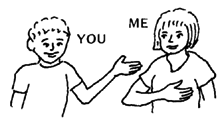
In other places even pointing with an open hand is not polite, and people point with their lips.
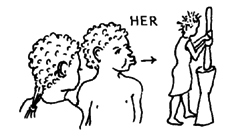

In the signed alphabet used in the USA and Canada the letter 'T' is made like this.
However, in many countries, this is an offensive gesture.
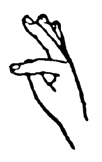
Therefore, in this book we also use the 'T' sign from Spanish and Danish.
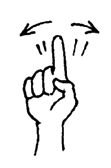
Also avoid confusion. For example, the sign for "WHERE" in the USA is a common gesture for "NO" in Mexico.
-
Use local signs. If people in your area already have a gesture or sign for something, use that instead of a new or foreign one. For example:
The American sign for NO is this:
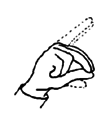
Some countries use this sign for NO:

In Jamaica NO and NOT are often said by a negative look and shake or tilt of the head.
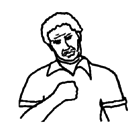
NO,
NOT METhe American sign for SLEEP is this:
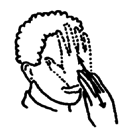
In Nepal this sign is used for SLEEP. It is understood almost everywhere.
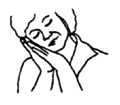
-
Use hand shape, position, movement, and direction to make different signs. The expression on the face also adds to meaning. For example, here are signs for MOTHER:
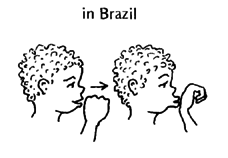
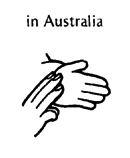
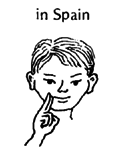
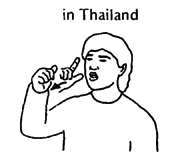
-
Try to make signs look like the things or actions they represent. To do this you can use a combination of hand shapes and movements.
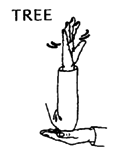
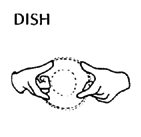
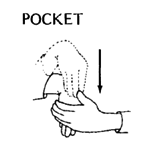
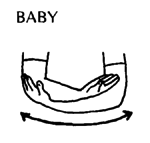
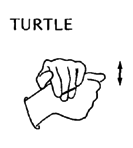
Figure out patterns and series of similar signs for related things and actions, and for opposites. For example:
|
|
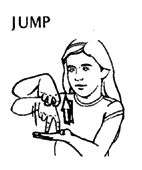
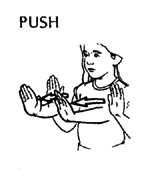
|
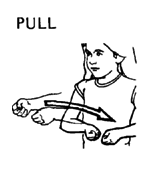
|
See other signs with fingers as legs on Page 272.
-
Learn new signs by pointing to things.


-
Combine signs for things and actions to communicate ideas or sentences. The arrangement of words does not need to be the same as in the spoken language - and you can leave out 'extra' words like "the" and "a." Also, words like "to" or "from" can often be left out or can be indicated by the direction of a motion.
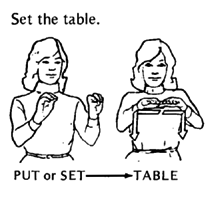
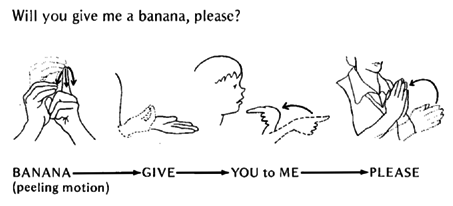
-
Decide whether or not to use letters of the alphabet to make some signs. In some sign languages the first letter of a spoken (written) word is used as the sign for that word. At first this will mean nothing to a child who cannot read, and will be harder. But it can help prepare the child for learning to read and to finger spell. Again, be systematic:
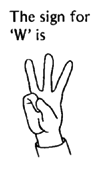
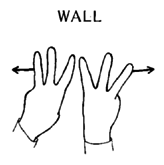

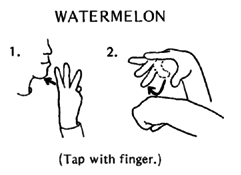
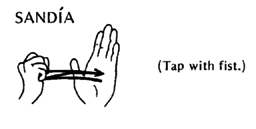
Be sure that letter-based signs agree with the word in your language. In Spanish, "watermelon" is "sandía," so the English sign makes no sense. The Spanish sign is:
-
You can make up signs for people's names by using the first letter of their name, by showing something that stands for that person, or both.
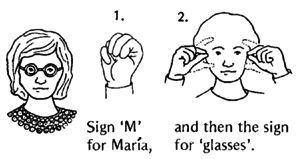
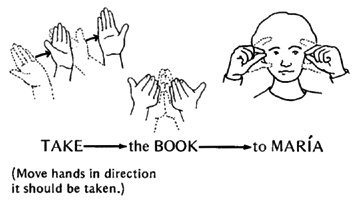
HOW TO ASK QUESTIONS
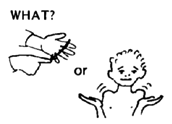
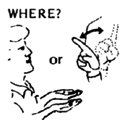
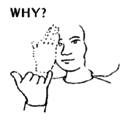
|
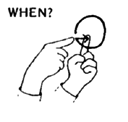

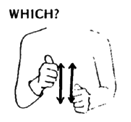
|
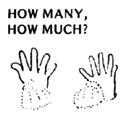
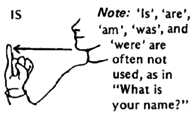
|
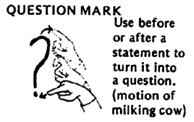
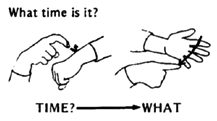
|

|

|
EXAMPLES OF SIGNS
- The signs shown here are mostly used in the United States (American Sign Language). A few are from Nepal, Jamaica, and Mexico, because these seem easier to understand. We have chosen signs for things and actions that should be useful for early learning and group games with children. We include them mainly to give you ideas. Change and adapt them to better fit your area.
- •Arrows (
 ) in the drawings show the direction of hand movement to make the sign.
) in the drawings show the direction of hand movement to make the sign. - • Wavy lines (
 ) used with a sign mean a shake of the hand or fingers.
) used with a sign mean a shake of the hand or fingers. - • Dotted lines (
 ) show how the sign looks when it begins.
) show how the sign looks when it begins. - • The darker sign is how it looks when it ends.
|
Note: A few signs shown here are based on letters of the alphabet (for example, 'it' uses the letter 'i', and 'we' the letter 'W'). Change these signs if you speak a different language, or if you want to avoid signs based on letters. |
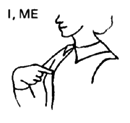
|

|
Note: The male and female signs are used as the base to make signs for boy, girl, father, mother, etc. |
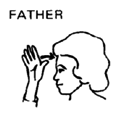
|
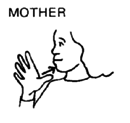
|
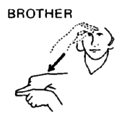
|
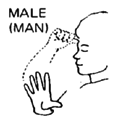
|
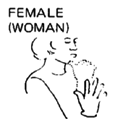
|
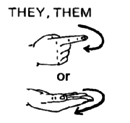
|
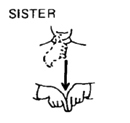
|
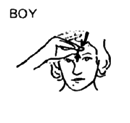
|

|
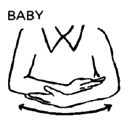
|
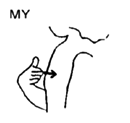
|
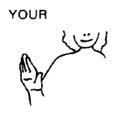
|
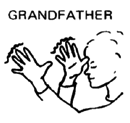
|
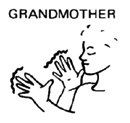
|
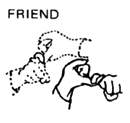
|
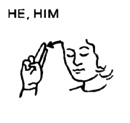
|
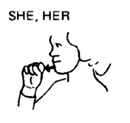
|
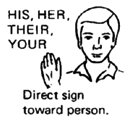
|
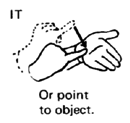
|
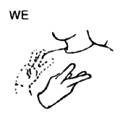
|
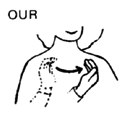
|
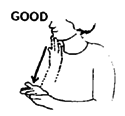
|
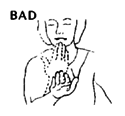
|

|
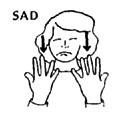
|
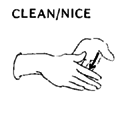
|

|
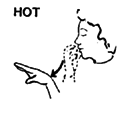
|
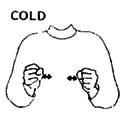
|
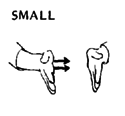
|
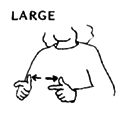
|
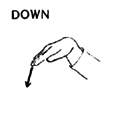
|
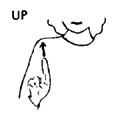
|
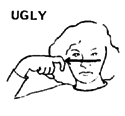
|

|
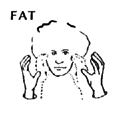
|
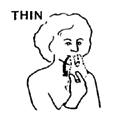
|
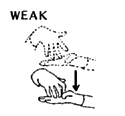
|
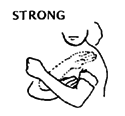
|
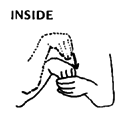
|
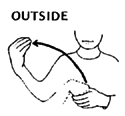
|
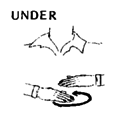
|
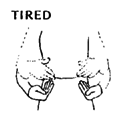
|
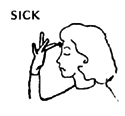
|

|
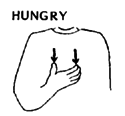
|
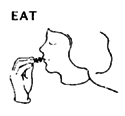
|
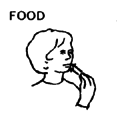
|
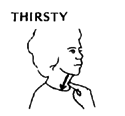
|
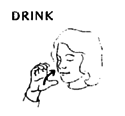
|
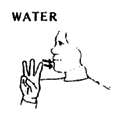
|
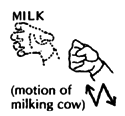
|
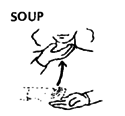
|
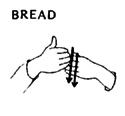
|
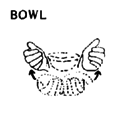
|
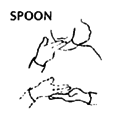
|
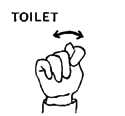
|
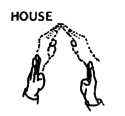
|
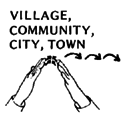
|
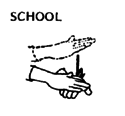
|
|
MONEY
|
MONEY 
|
MONEY 
|
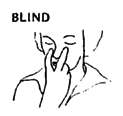
|
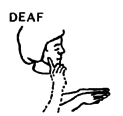
|
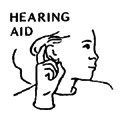
|
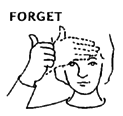
|
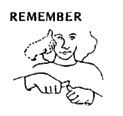
|
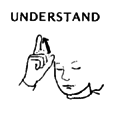
|
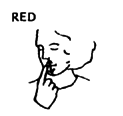
|
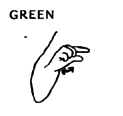
|
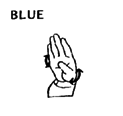
|
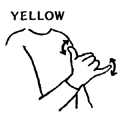
|
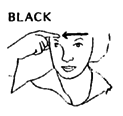
|
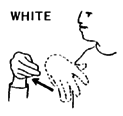
|
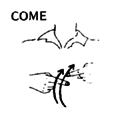
|
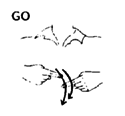
|
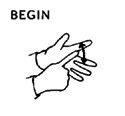
|
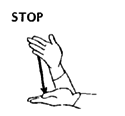
|
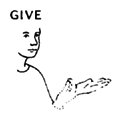
|
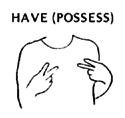
|
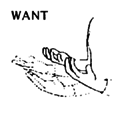
|
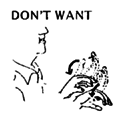
|
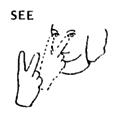
|
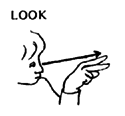
|
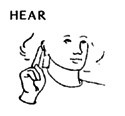
|
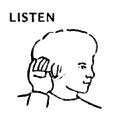
|
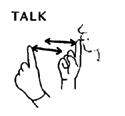
|
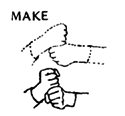
|
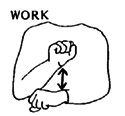
|
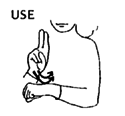
|
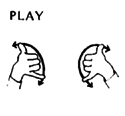
|
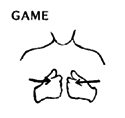
|
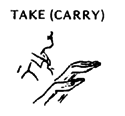
|
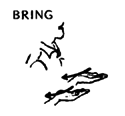
|
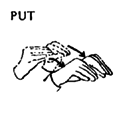
|
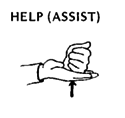
|
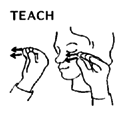
|
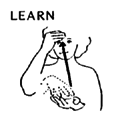
|
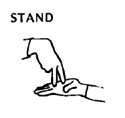
|
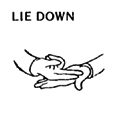
|
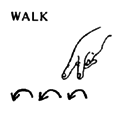
|
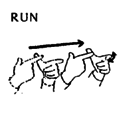
|
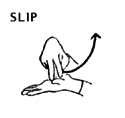
|
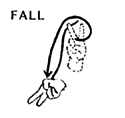
|
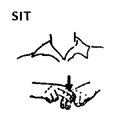
|
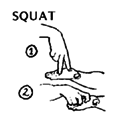
|
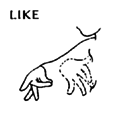
|

|
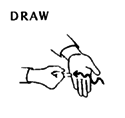
|
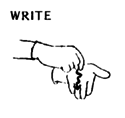
|
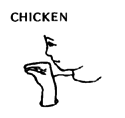
|

|
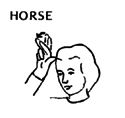
|
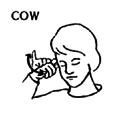
|
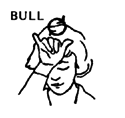
|
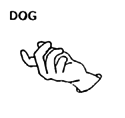
|
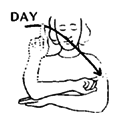
|
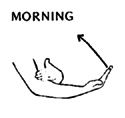
|
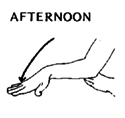
|
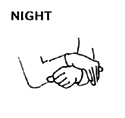
|
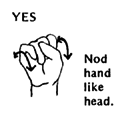
|
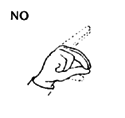
|
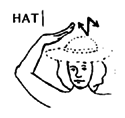
|
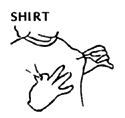
|
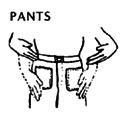
|
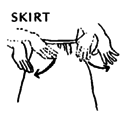
|
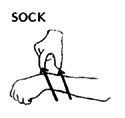
|
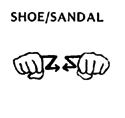
|
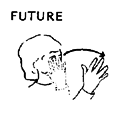
|
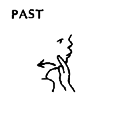
|
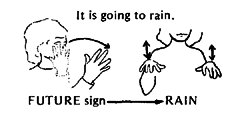
|
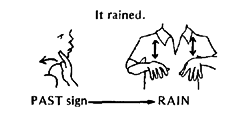
|
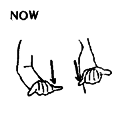
|
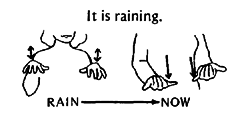
|

|
NUMBERS (one of many systems)

|

|

|

|

|

|

|

|

|

|

|

|

|

|

|

|

|

|

|

|

|

|
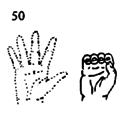
|
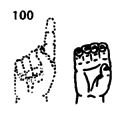
|

|
|||
ONE-HANDED SIGN ALPHABET (American)

|

|

|

|

|

|

|

|

|

|

|

|

|

|

|

|

|

|

|

|

|

|

|

|

|

|

|
Helping the child learn to make sounds and speak
1. If the child hears at all, encourage her to notice and listen to different sounds, as discussed on Page 262.
2. Play games and do exercises to help her learn to use her mouth, tongue, and lips (see Page 314and Page 315). Have her press her lips together as if saying "mmm," ![]() , make a circle like 'O'
, make a circle like 'O'  , and stretch her mouth and smile as saying "eee"
, and stretch her mouth and smile as saying "eee" ![]() .
.
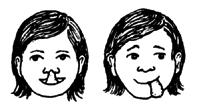
See if she can touch her nose, her chin, and her cheeks with her tongue. Have her blow soap bubbles, or blow out candies. Give her foods to chew and suck.
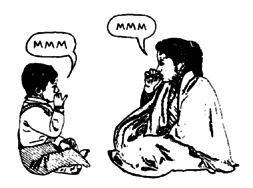
3. Encourage the child to begin to make sounds. 'Mmm' is good to start with because it is easy to make. If necessary, show the child how he can hold his lips together to make it. Sit close to him so he can see (and hear?) and copy you. Other sounds that are usually easy to learn are 'ah', 'ay', 'ee', 'aw', 'o', 'p', 'b', 't', and 'd'. (Keep more difficult sounds like 'v', 'w', 'j', 's', 'n', 'r', and 'z' for later.)
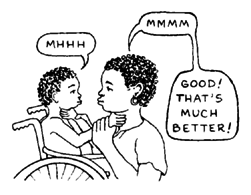
4. If the child uses his mouth and lips, but not his voice, have him feel the 'buzz' or vibration in your throat when you make different sounds. To get the 'feel' of different words, you can place his hands on your cheeks, lips, throat, and chest. Then have the child feel his own throat, as he tries to copy you.
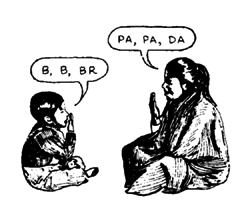
5. Also have the child feel and compare the movement of the air in front of your mouth and his mouth with sounds like 'ha', 'he', 'ho', 'm', 'p', 'b', and 'f'.
In the same way, have him feel the air move when he 'blows his nose' with his mouth closed. Using this, try to teach sounds like 'n' and '1'.
6. Begin to teach the child words using the sounds he is learning. First separate the word into different sounds. To say "Ma," first get the child to say "m" with the lips closed. Then "ah" with the mouth open. Then say the word "mah" and have him try to copy you.
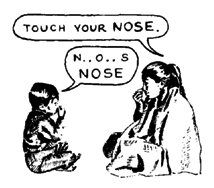
7. As the child learns words, leach him what they mean, and have him use them. For example, to teach the child 'nose', have him make the sounds 'n', 'o', and 's'. Then have him put them together. Ask the child to touch his nose as he says the word. Have him copy you. Praise him, and make it a game.
8. Little by little, help the child learn more words and practice using them through games and daily activities. Have her learn her own name and the names of family and friends. Build up a word list as explained on Page 265. But do not try to go too fast. Take time to help her say a few words fairly clearly before going on to the next.
Lip reading
Children with a lot of hearing loss often depend partly on lip reading to understand what people are saying. But lip reading is not easy to learn. Do not try to hurry the child or she (and you) can easily get discouraged. Do not start teaching lip reading until the child is at least 3 years old.
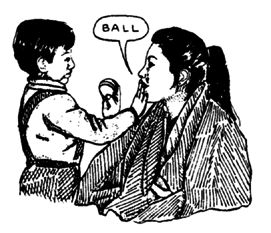
Sit in front of the child in good light, and show him something, for example, a ball. Say "ball," moving your lips clearly and speaking slowly. Let the child see your lips move, and watch your face. Repeat the same word many times.
Then have the child try to imitate you, and feel his own lips as he does.
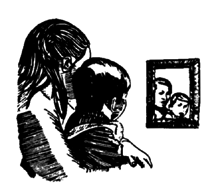
Next, sit with the child in front of a mirror, so that he can see both of your faces. Say the word 'ball' and then have him copy you, watching both of your lips and faces in the mirror.
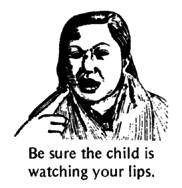
In this way teach him different words. Start with words where the lips move a lot, and that are easy to tell apart. Pick words that you can use often with him in games and daily activities. When you speak to him, make sure he is watching your face and mouth. Use hand signs when he cannot understand a word. But use the sign after speaking the word, not at the same time. He cannot watch both at once.
You can play games with the child together with children who hear, using 'mime' - that is, acting things out and saying words with the mouth, without making sounds.
Unfortunately, some sounds and words look exactly the same on the lips-the sounds 'k', 'g', and 'h', look the same. 'P', 'b', and 'm' look almost the same. 'T', 'd', 's', and 'z' look the same. And so do 'ch' and 'j'. To help the child tell similar words apart, use hand signs or give him small 'clues', like touching parts of the body, clothes, or food. For example:
|
If mama wears a dot on her forehead,
|
|
and papa has a scar on one cheek,
|
|
when anyone at home speaks of them they can also give the 'magic sign'.
|
PREVENTION of deafness
- Take steps to prevent ear infection (teach the child not to blow her nose hard when she has a cold). Treat ear infections at once when a child gets them. If the child has frequent ear infections, see a health worker or 'ear doctor'. Do not put leaves or plugs of cotton in an infected ear. Let the pus run out. See Page 309 in Where There Is No Doctor.
- During pregnancy, do not take medicines that might harm the baby. Tell the health worker or doctor you are pregnant, and ask him to check if the medicine he prescribes is recommended during pregnancy.
- Vaccinate girls and women against German measles (rubella) before they get pregnant (but never when pregnant). Or let young girls catch German measles by letting them play or sleep with a child who has them. This will give them a 'natural' vaccination. Pregnant women should avoid getting near anyone with German measles.
- Have regular medical check-ups during pregnancy.
- Eat as well as possible before and during pregnancy, use iodized salt, and include foods rich in iron and other vitamins and minerals.
- Look for signs of cretinism in the baby, and treat it early (see Page 282).
- Vaccinate the baby against measles (and, if possible, mumps).
- Take precautions to prevent brain damage and cerebral palsy (see Page 107 and 108).
- Never put, or let the child put, pointed objects in the ears.
- Avoid being near very loud noises. When a child cannot avoid them, teach him to cover his ears, or use ear plugs.
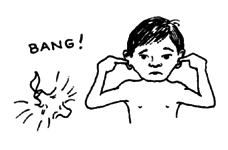
Words to the family of a deaf child
Deaf children can grow up to be loving and helpful sons and daughters, like other children. Try to let your child grow up. Give him the same rights and responsibilities as other children his age.
If there is a chance for your child to go away to a school for the deaf, if it seems right, try to let him go. Deaf children learn in different ways than other children. The special school may provide more opportunities. However, if your child is doing well at the village school, has a teacher who understands and helps him, and has many friends, he might do better there. Help him understand the choices and see what he thinks would be best. Be sure he knows he has a loving family to come home to.
After they finish school, deaf children can do many different kinds of work. Deaf people have become accountants, teachers, lawyers, farmers, health workers, clerks, skilled craftsworkers, and doctors. It is worth the effort to see that deaf children and adults get training and find work.
Be careful that after he has grown up, you do not treat him as a child. He might seem younger than his age. But the best way to help him grow up is to expect him to grow up.
When deaf children grow old enough to marry, they often choose to marry someone else who is deaf, for they can understand each other better. They can have children, and raise them well. Usually a deaf mother and father have children with good hearing.
It is difficult to be deaf. You can help persons who are deaf by letting them communicate in ways they find easy, and by trying to learn to communicate with them yourself.
Disabled Village Children
A guide for community health workers,
rehabilitation workers, and families
by David Werner
Published by
The Hesperian Foundation
P.O. Box 11577
Berkeley, CA 94712-2577

